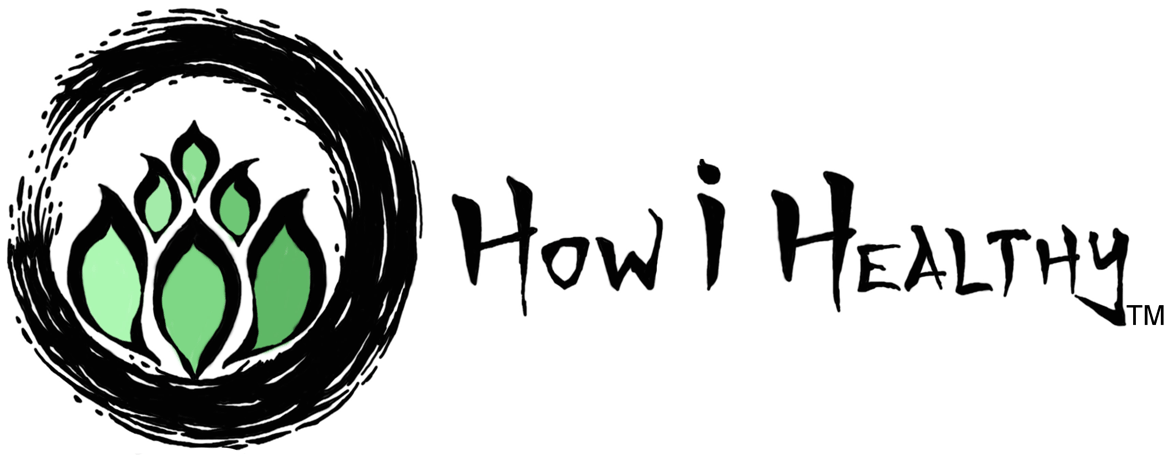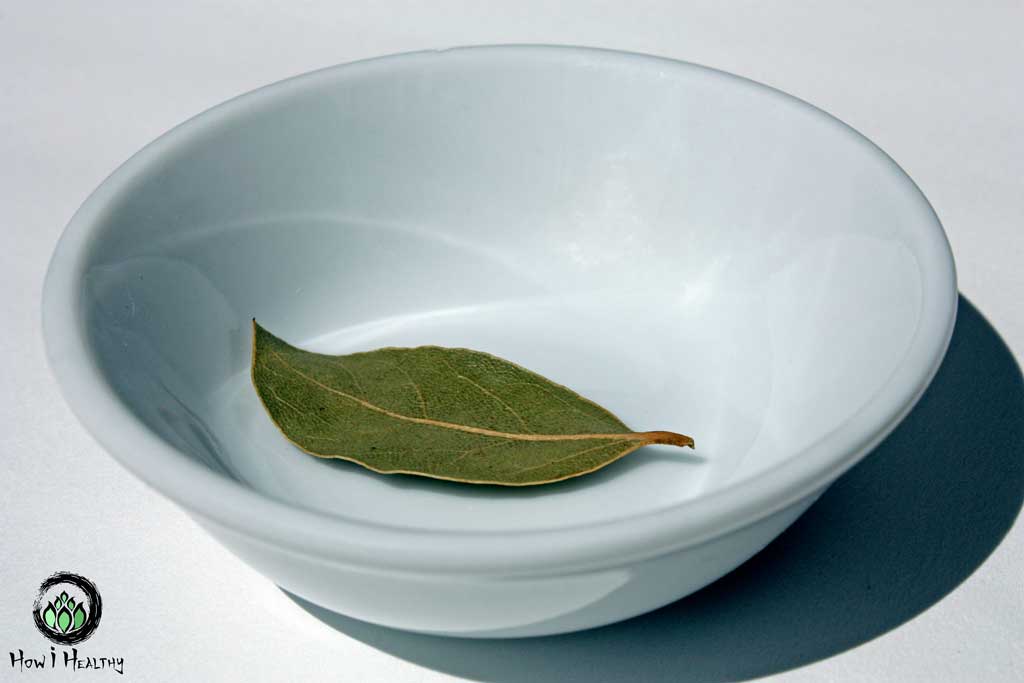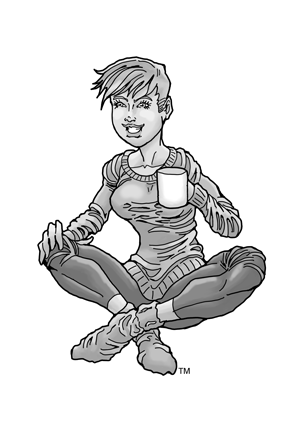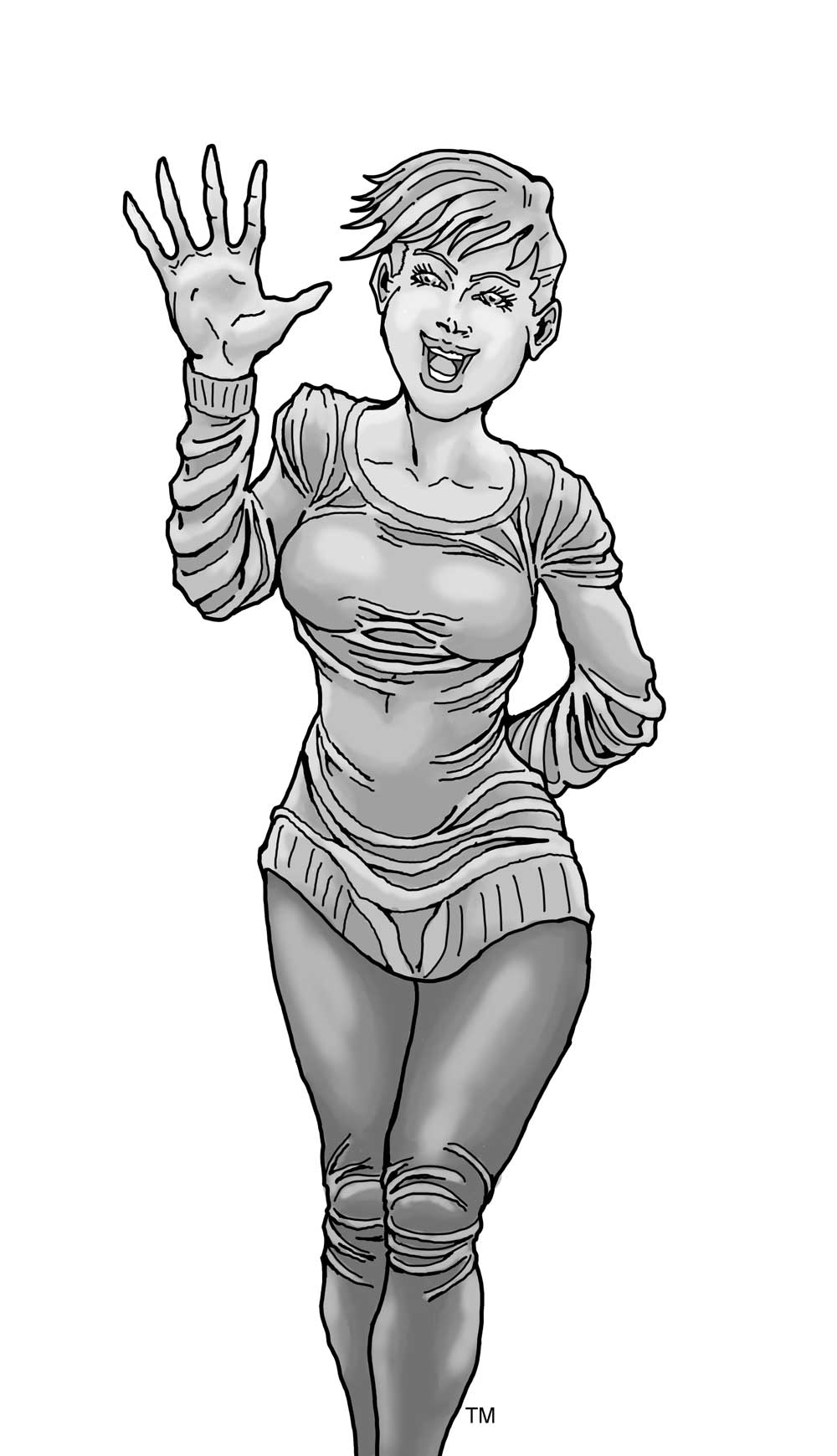In This Article, We'll Cover:
- The Problems with Chemical Hair Dye
- The Basics of Plant-Based Natural Hair Dye
- Henna History & Facts
- The Science of How Henna Works
- 6 Myths About Henna and Why They Are Wrong
- How to Use Henna to Naturally Dye Hair
- How i Healthy’s Favorite Henna Brand & Why
I have a confession. I’m not a natural redhead. I dye my hair.
But most people think that it is my natural color, even hair stylists!
Well, the product I use is plant-based, so I suppose I could say I’m a “natural” redhead! Ha!
Let’s go with that.
How do you achieve a chemical-free red that looks like the real deal? One word.
Henna.
Often associated with temporary tattoos, henna also achieves natural permanent hair color. When mixed with other plants like indigo or cassia, henna can achieve a spectrum of colors, not only reds.
You heard that right, plant-based, permanent hair color, in many color options.
Problems with Hair Dye
Before we explore why henna is so awesome, why not use regular hair dye?
First, let’s cover some hair dye basics.
There are five types of hair dyes:
- Gradual dyeing by use of metallic salts, lead, or bismuth.
- Vegetable/plant based dyes like henna, cassia, and indigo
- Temporary dyes that don’t penetrate the hair shaft, these wash out after shampooing
- Semi-permanent dyes that do penetrate the hair shaft and resist several washings
- Permanent/oxidation by chemically penetrating and altering the hair shaft
(6, 19)
Well-sourced vegetable dyes don’t contain harmful chemicals or pose significant health risks.
Chemicals and health risks like:
Para-phenylenediamine (PPD)
PPD, a common additive to hair dyes. (6)
PPD was voted the “Allergen of the Year” by the American Contact Dermatitis Society (ACDS). Several times. (6, 7)
Not the award I’d like to win.
Prohibited since 1938, PPD is absent in cosmetic skin applications. One expectation. Hair dye. (7)
PPD has been linked to moderate to severe allergic reactions. Reactions like dermatitis, edema, blisters, eyelid swelling, hypopigmentation, keloid scarring, urticaria (hives), inflammation, anaphylaxis, and even death. (6,11)
Reactions can start mild and worsen with continued applications. (6, 11)
For example, actor Pauley Perrette, known for her role in NCIS as a forensic scientist, had an allergic reaction to her black hair dye. But only after years of use. Allergic reactions to PPD can compound, as it did for Perrette. She first had mild symptoms that exacerbated after prolonged use. Eventually, her head swelled, and she required hospitalization. (10)
Lead As Lead Acetate
Lead toxicity can cause many health problems and can lurk in the most unlikely places. Seriously, just check out the List of Where Lead Lurks.
Hair dye is no exception. Hair dye can contain lead acetate. A chemical the Food and Drug Administration (FDA) considers a safe additive in hair dye. (25)
A 2017 petition demanded to revoke this approval to establish new regulations. On October 30, 2018, the FDA ruled to require hair dye follow code: 21 CFR 73.2396. That means that hair dye containing lead acetate must disclose so on packaging. (25)
That’s good. Kinda.
It still means hair dye can still contain lead acetate. Only now packing must simply disclose it. The FDA gave companies 12 months to change its processes to meet the new requirements. (25)
Cancer? Yes. No. Maybe. We’re Not Sure
Prolonged use of chemical hair dye, particularly dark pigment hair dyes, might increase the risk of developing cancer and brain tumors. (19, 20)
But for every study showing a hair dye-cancer relationship there is another study suggesting no relationship or lack of definitive findings to draw any conclusions. (19, 20)
The American Cancer Society agrees there is not enough conclusive data for either statement.
But there could be other factors involved that might compound with hair dye use. (20)
Factors like:
- Direct exposure through topical application or occupational exposure. e.g. Hairdresser vs. salon client.
- Duration of exposure, both short and long term.
- Exposure before 1980. Pre-1980 hair dye included aromatic carcinogens.
- Pigment color of dye. Darker colors posed more risk in select studies.
(19, 20)
Pregnancy Risk? Again, Maybe. We’re Not Sure.
Research on hair dye while pregnant is contradictory. (21)
Researchers found a risk of neuroblastoma cancer in children whose mothers used hair one month before conception and through pregnancy. Another study concluded no risk for children developing brain tumors. (21, 22, 23)
There is not enough data concluding whether hair dye while pregnant is without risk or not. (20)
Widespread Use
Hair dye use is pervasive around the world, up to 92% in some countries where surveyed. Some people start from as young as 12 years old. (24)
That’s a lot of exposure to chemicals with inconclusive consequences.
What are we to do? What are the alternatives?
Henna 101
Enter; henna. The greatest plant-based dye around.
What Is Henna?
Henna is powdered Lawsonia inermis, a shrub-like desert flowering tree of African origin. Drought resistant, henna thrives in the Arabian Peninsula, Persian Gulf, Middle East, Asia, and India. (1, 3)
Henna extracts can potentially contain antioxidant, anti-inflammatory, antibacterial, and even antitumor/anticancer capabilities. Further study and testing on the pharmaceutical potential for henna is ongoing. (3, 9, 16)
Quick Henna Overview
A lot happens with henna.
Here’s a visual timeline of henna mixing basics. We’ll dive into the details in a moment:
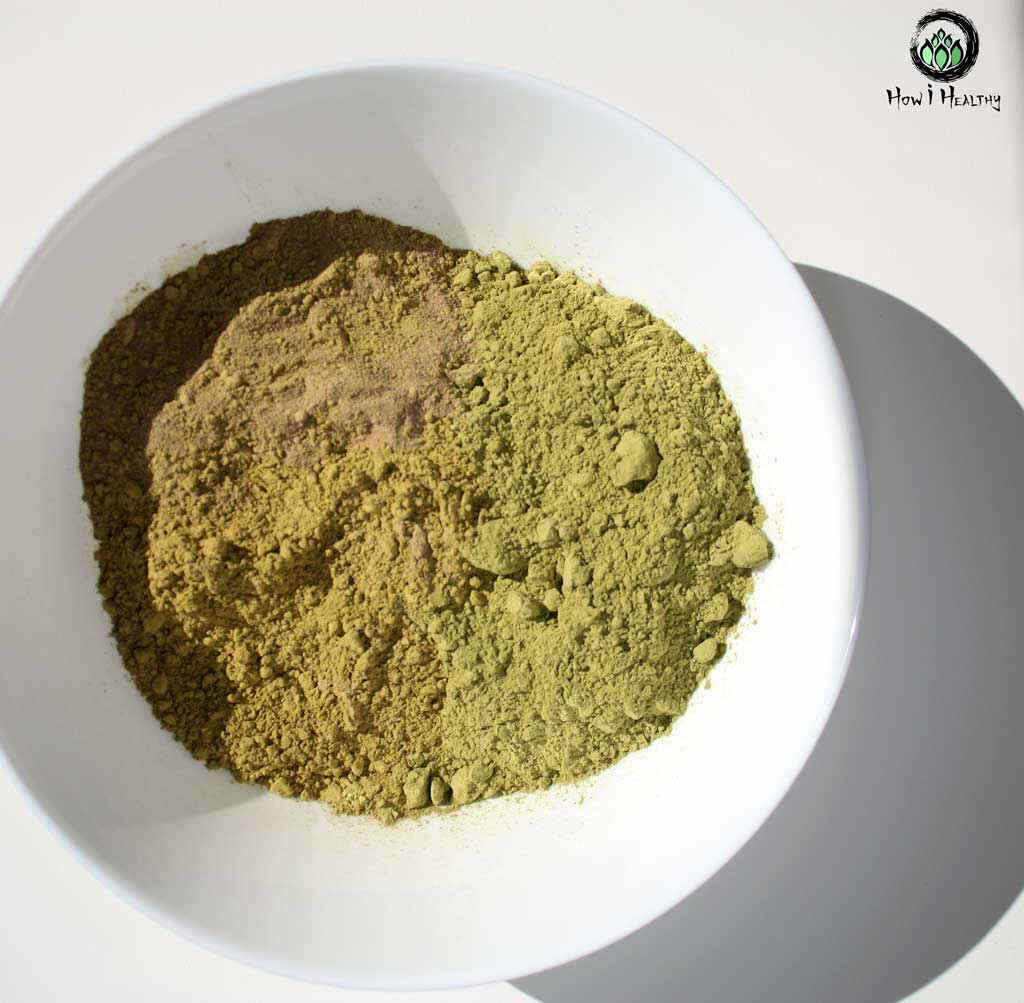
- Start with henna, cassia, & copperberry powder.
- Henna is the greener power to the right.
- Cassia is the golden powder to the bottom left.
- Copperberry is the rust-colored powder to the upper left.
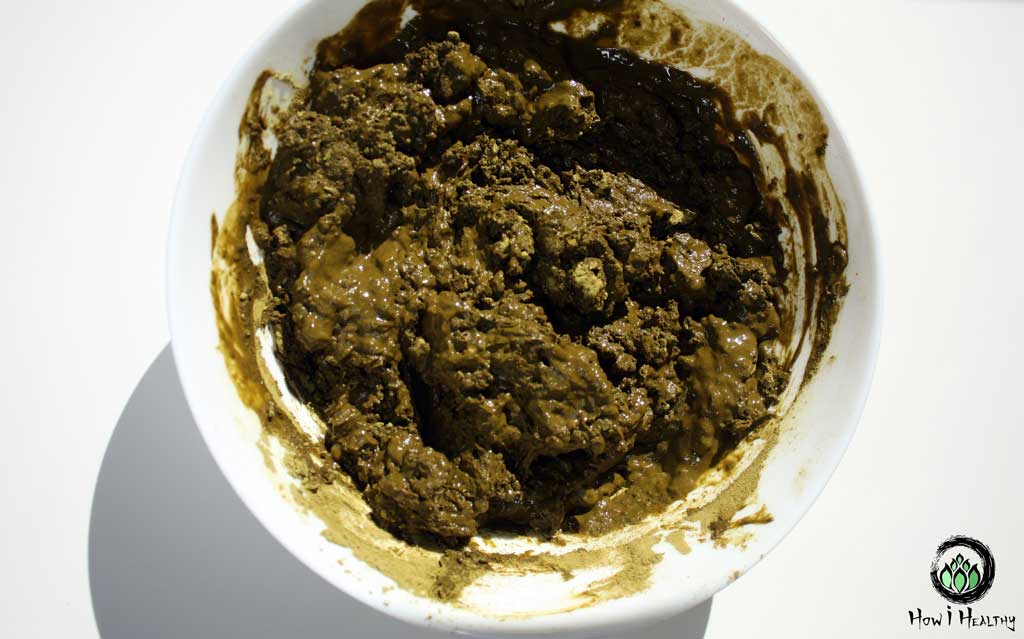
- Add distilled water.
- This needs more water. See the clumps and dry bits?
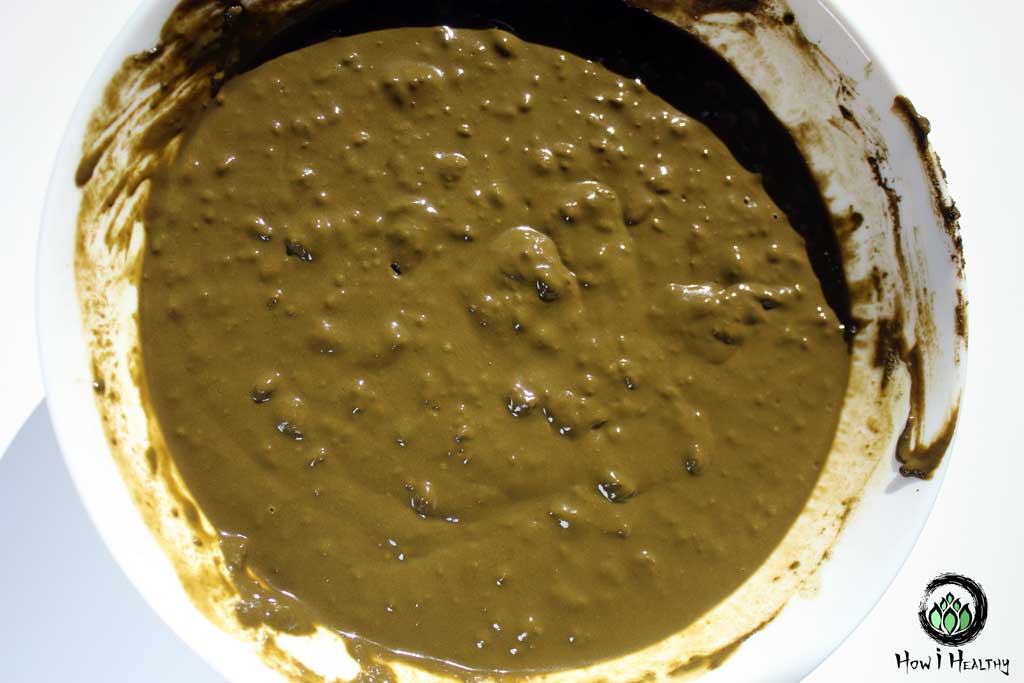
- That’s better! We’re looking for a sour cream consistency.
- Henna needs to be smooth enough so we can apply it to hair, but not so runny that it will drip.
- There’s still some clumps, but after resting those will smooth out.
- And yes, it is green! For now…
- Let this mix rest 8-12 hours/overnight.
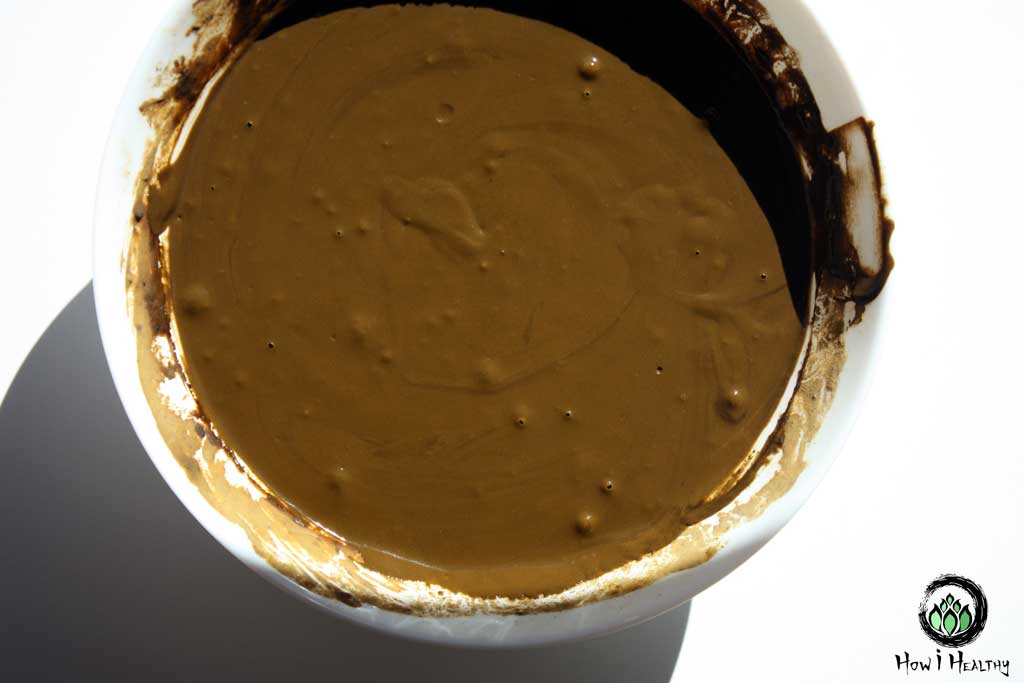
- Gorgeous!
- After resting overnight, the green yields to a rusty copper and is ready for hair application.
- Note: The color of this mixture is not what the final hair color result will be. It might seem counterintuitive, but this rusty paste will turn most hair a shade of red.
- Initially, the color will be a bright orangey red.
- Three days post application, the color darkens, the orange fades, and a gorgeous red shade appears.
Chemistry of Henna
Let’s dive a bit more into henna.
Application Process:
- Henna powder is mixed with an acidic like copperberry powder or lemon juice. Adding other plant powders like cassia or indigo creates shades of blonde, brunet, or black.
- The mixture rests at room temperature for up to 8-12 hours.
- The henna-acid mixture changes from a mossy green color to rusty copper
- This paste is applied to hair and rests for several hours.
- The mixture is washed out.
Lots of science explains why all these reactions occur. The main reason is Lawsone:
- Lawsone, the active compound within henna, alters pigment and color. (1)
- When exposed to mildly acidic powders (copperberry) and to keratin (hair or skin), Lawsone oxidizes. (1)
- Oxidation causes the color change. (1)
- Oxidation takes time to work its magic.
This means hair darkens a few days post application. Some acids (like copperberry) reduce oxidation. But other mixtures, like lemon juice, can cause drastic oxidation. One isn’t better than the other, it all depends on what color you’re looking for.
Well-sourced henna and the right acidic mixing agent is critical for coloring success.
Henna mixed with an improper pH liquid, like water without any acidic powder added, will not bind with keratin. The henna will fade or wash out over time.
Low quality henna, or henna with a low Lawsone content, will also fade. Without enough Lawsone binding to the keratin, the dye uptake diminishes, and results are less vivid. (1
History of Henna for Hair
The use of Lawsonia inermis as henna for body art has a long history steeped in culture and tradition.
Henna for hair is just as ancient.
Egyptian mummies have not only red dyed skin and nails, but also hair. Artistic depictions of people with red henna hair span continents and centuries. (4, 13)
But henna in hair has more than aesthetic or cosmetic uses.
Henna has antifungal properties. Because of this, henna was also a natural treatment for some types of dandruff and tinea fungal conditions like ringworm and jock itch. (15, 16, 17)
Henna can also kill head lice in a single application. (18)
Benefits of Henna
It’s plant-based permanent hair color! That’s the best benefit!
I used henna for the first time 10 years ago. The auburn tones are as vibrant as ever.
The red hasn’t faded in the slightest.
I’ve only touched up my roots.
Seriously, I only henna my roots every 6-8 weeks. Just the roots. For years. I haven’t touched the rest of my waist length hair.
2023 Update: I buzzed off my waist length hair! But I still henna my super short hair. 10+ years and counting. I love henna!
Busted: 6 Myths About Henna For Hair
1. “Henna Comes In Many Colors” & “Black Henna”
Henna from Lawsonia inermis only comes in one color. The rusty-brown, auburn shade of red. (4)
“Black”, “brown”, or ”blond” henna are often mixed with other compounds. Sometimes natural plant-based ones and sometimes chemical ones. (4, 7)
But “Black henna” deserves special caution.
“Black henna” is often henna mixed with PPD, a chemical component common in conventional hair dye. Typically, the darker the dye, the higher the concentration of PPD. (5, 6, 7, 11)
Canadian law prohibits the sale of “black henna”. (8)
The United States? Not so much. (7)
Some state laws protect consumers, particularly minors who get “black henna” tattoos at “vacation hotspots”. But that often means just requiring parental consent. Other than that, “black henna” sales go unchecked. (7)
Plant based compounds, like indigo or cassia, create blacks, browns, and blondes when mixed with henna. But henna alone is only orange-red.
Ancient Sunrise® Henna Hair Kits are specially packaged and premeasured to create natural plant-based colors like reds, blondes, blacks, and browns. Those fantastic kits mix henna with cassia, indigo, and different fruit acids to create a rainbow of color options.
So, if you find a box of henna claiming another shade, read the label. If indigo or cassia isn’t listed, I’d just move along.
2. “Henna Is Henna, Any Henna Will do”
Not all henna is good henna.
Henna is frequently contaminated with unnecessary substances, additives, and chemicals. (1, 2)
Heavy metals like mercury, aluminum, cadmium, nicrosil, and lead could be in henna, especially “black henna”. (26)
Additives like lead acetate, or coal tar like PPD (para-phenylenediamine) and 2 Nitro (2-nitro-p-phenylenediamine) can be in henna. (1, 4, 7, 26)
Lower quality henna often contains less Lawsone content, resulting in poor dye uptake. (1)
Without quality henna, the color, the potency, the vibrancy, and the permanency of the dye is subpar. And the risk of harmful chemicals or heavy metal exposure increases as well.
3. “Instant Henna” & “Fast Acting Henna”
Henna is not fast.
After mixing henna with an acidic liquid, it rests for 12-15 hours.
Then there’s still the matter of putting it on your hair.
Once you do, the henna needs time to release. 3-5 hours on average.
My henna rests on my counter for ~12 hours.
And then for 5 hours on my head.
It’s a commitment.
A henna product that claims results in less than an hour makes me extremely skeptical.
It’s a chemical process that takes time to oxidize.
“Instant color”, or “fast acting” are red flags. Additives might be speeding up the dyeing process. Questionable additives. (11)
4. “I Can’t Use Henna if My Hair Is Chemically Dyed or Bleached”
Well-sourced henna should not react with chemically dyed or bleached hair. But test a clump of hair gathered from a hairbrush before applying to your head just to make sure. (27, 28)
For myself, I had chemically dyed red hair before applying henna. The henna took to both the chemically dyed hair and non-colored roots, blending the two.
But there are many factors that affect henna. I researched my technique, sourced my henna, and tested several batches of my hair to ensure a result I liked.
5. “I Can’t Use Chemical Dyes After Henna”
If you do try out henna and don’t like the result, chemical dyes applied over the henna are most likely okay to do. (29)
But test first!
Gather hair from a hairbrush. Make sure that the henna and new chemical dye you want to transition to are compatible.
Still not sure?
Dye a hair sample with henna and then use that same sample to dye it again with your chemical dye. That way you can see the whole picture if you change your mind after henna and want to go back.
6. “Henna in Hair is Temporary”
Nope! Not quality henna with high lawsone content. That stuff is permanent.
When I decided to henna my hair, I committed to being a redhead long term.
If you change your mind about your henna, you do have a few options:
- Grow it out.
- Cut it off.
- Chemically dye it over, but only if the hair tests went well.
- Naturally dye it over with other plant dyes like cassia or indigo.
7. “Henna Only Works On Light/Fine Hair”
Henna is powerful.
While it takes to hair differently, henna is an option for most hair colors and types.
Check out this list of options for 3c to 4c curls of all colors.
Even those with a similar starting hair color will have different results. (28)
This is why testing your hair before applying is critical.
Henna is more prominent in lighter hair colors, but that doesn’t mean it won’t work on darker colors. Henna applied to dark can bring out highlights or auburn undertones.
How To Henna
Here’s what you’ve been waiting for, the How To!
Henna is an art and science.
Sourcing, mixing, resting, applying, how long to leave it on for. It’s all important to get the best results and avoid a disaster.
Understand That Henna is Personalized
Henna really is “For You”. Your recipe, your mix.
That’s because Henna reacts differently, depending on:
- Curl pattern.
- How fine a grain the henna is.
- How long the henna rests once mixed for dye release.
- How warm or cold a room is while the henna rests.
- Original hair color & quality you want to cover.
- What acidic liquid or powder the henna is mixed with.
- What brand of henna used.
- Whether original hair is natural, grey, bleached, or dyed.
- Whether the henna is mixed with other plant dyes like indigo or cassia.
That’s why this article won’t detail “the right way” to do henna, because the process is different for everyone.
My personalized henna protocol is:
- Mix henna with cassia and copperberry fruit acid
- Rest for 10-12 hours on the counter
- Freeze overnight (or until I need it)
- Thaw
- Apply to roots
- Leave in for 5 hours
- Wash out
That’s the way I’ve done it for years.
And other people have a different method that is suited for their hair.
My natural hair is curly and honey blonde. Doing my process on some else’s hair will have different results. My friend rests her henna for only 2 hours, her hair is blonder, straighter, and finer than mine.
Some people don’t freeze and thaw their henna, I prefer to. I find freezing creates a more vibrant color.
Read The Guide
The Ebook, Ancient Sunrise® Henna for Hair© by Catherine Cartwright-Jones, PhD is the best henna resource I have ever found.
It details the history, art, and science of henna. And contains step-by-step photo instructions on various henna techniques for different hair types.
This guide is the reason I don’t write my own. No need to reinvent the wheel.
The guide is available online. It’s free, no purchase necessary.
The chapters and sub chapters are clearly laid out, user friendly, and easy to navigate.
I printed out chapters 7 and 8 to use as a reference during my first henna application. Both chapters have checklists of equipment and visual aids.
Bottom line. Read the guide. It’s the best authority on henna technique.
Test First!
I can’t stress this part enough. Test a batch of hair before doing your entire head.
Chapter 7 of Ancient Sunrise® Henna for Hair© is an excellent guide for testing henna.
Collect loose hair from a hairbrush and batch test several clumps. Play with factors like:
- Additives like cassia, indigo, or fruit acids.
- Duration of resting henna before application.
- Duration of application.
- Temperature of the henna.
All these factors can alter color of the final product.
When I first explored henna, I tested six clumps of my hair.
Yes, it did take a bit of time to gather that much hair to test. I made a chart that tracked all my variables.
After waiting a few days for the henna to oxidize, the final color presented itself. And I choose which process yielded my desired results.
My Favorite Henna
Not all henna is good henna. Many products can contain mystery additives, PPD, or heavy metals. And henna with a low Lawsone content will cause poor dye-uptake. (1, 2, 26)

The How i Healthy Standard
Our favorite products/brands meet as many of these conditions as possible.
Healthy body, healthy planet, & healthy sex means:
- Align with My Best Sustainability & Ethical Tips
- As Local as Possible
- Cruelty-Free
- Doesn’t Contain these Harmful Chemicals
- Environmental and/or Socially Responsible Company
- Ethically Made: Fair Trade, Living Wages, Safe Worker Conditions
- Gender-inclusive
- No Greenwashing Scams
- Organic & Sustainably Harvested Ingredients
- Pass How i Healthy’s Counterfeit Vetting Process
- Purchased Through/From an Ethical Shop/Marketplace.
- Zero Waste / Plastic & Bioplastic-free / Home Compostable
- 1% for the Planet®, B Corporation®, Green American Business®, or similar credentials
With this in mind, let me introduce my favorite henna brand!
Ancient Sunrise® Henna Kits By Mehandi®
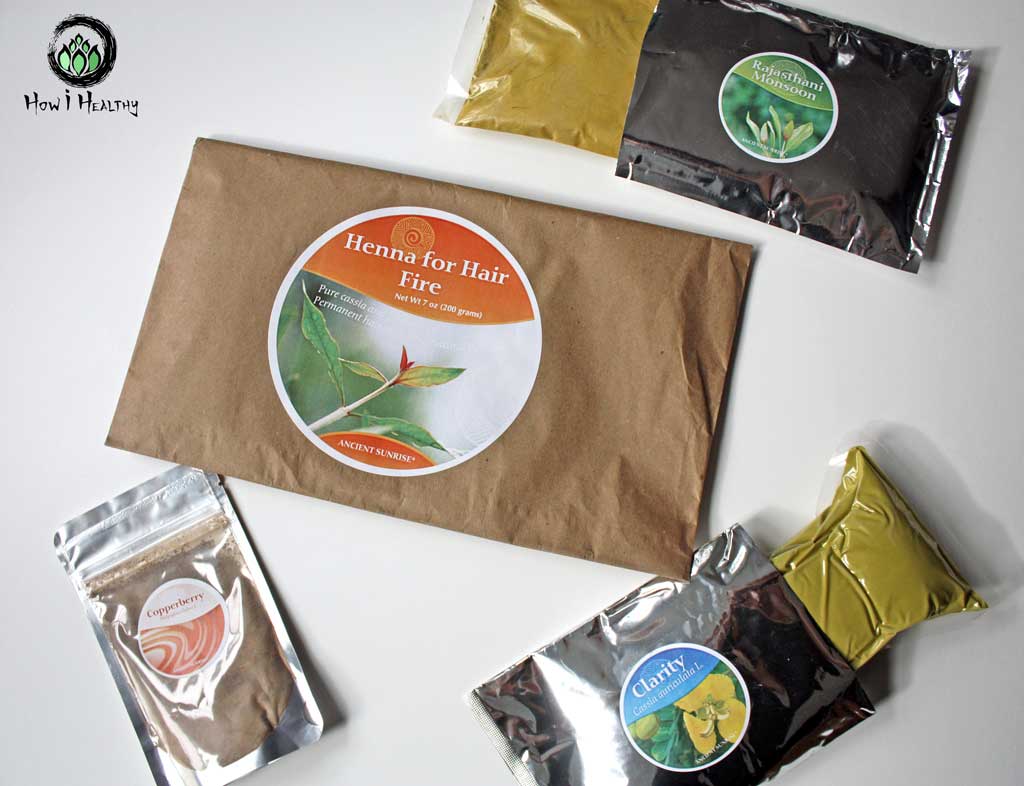

Product Kudos
Origin: India, packaged in Kent, Ohio.
End of Life: TerraCycle all-in-one box.
Ingredients/Packaging:
- Ancient Sunrise® Henna Hair Kits: 100% henna powder, cassia powder, and copperberry fruit acid.
- Packaged in foil, plastic, and paper bags.
Why It’s Awesome:
- Batch tested by an independent third-party lab. No harmful junk like lead, PPD, or pesticide residue. (30, 32)
- High lawsone content = awesome quality.
- Many color option & shades available; Blacks, blondes, browns, and reds.
- Everything you need premeasured out with step-by-step instructions.
Company Kudos
- Customer service. When folks know henna like the people at Mehandi® do, it’s no wonder they can answer any questions you might have. From product advice to henna technique, they are here to help!
- USA based company located in Kent, Ohio. (33)
- Woman-owned business. The owner, Cartwright-Jones, PhD, wrote her PhD dissertation on henna and henna related topics. She’s the academic authority on henna. Several of her many publications are referenced in this article. (35)
- Ancient Sunrise® henna is used for medical research purposes. The henna is high-performance liquid chromatography (HPLC) batch laboratory tested by Alkemists Pharmaceuticals. (30)
The Takeaway Message
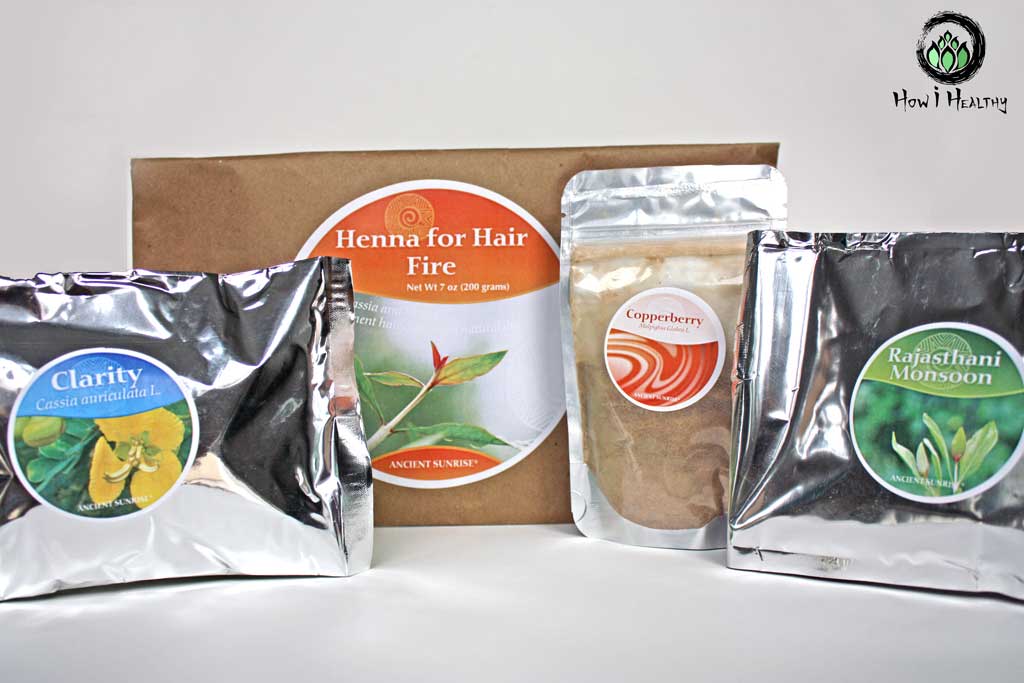
Chemical hair dyes might not be the best thing for our bodies:
- Chemical hair dyes can contain chemicals that can cause allergic reactions like dermatitis, edema, blisters, eyelid swelling, hypopigmentation, keloid scarring, urticaria (hives), inflammation, anaphylaxis, and even death.
- There is no medical consensus if hair dye links to cancer.
(6, 10, 11, 19, 20, 25, 21, 22, 23, 24)
Another option? Henna! A plant-based dye with fantastic, long-lasting results. What a beautiful thing!
When well-sourced.
Poorly sourced can mean:
Potentially containing things like lead, heavy metals, and Para-phenylenediamine/PPD.
“Black henna” is not pure henna. Instead, it’s henna with additives that can cause extreme allergic reactions.
(1, 2, 4, 7, 26)
But when well-sourced, henna is a natural & coast-effective alternative to toxic & expensive hair dye.
Henna yields permanent hair color that, in my experience, never fades.
I never had to redo my hair, only do root touch ups.
If you’ve tried dyeing your hair before, espeicaly red, then you know that chemical stuff fades fast! Not henna!
And it does more then just red:
Henna mixed with other plant powders like cassia or indigo yields many shades of red, blonde, brunet, and black.
Add fruit acid powders like copperberry and you can really customize color.
Because henna is so versatile depending on what you mix with it (i.e. cassia, fruit acids, indigo) it can be overwhelming to figure out what you need to get the results you want.
And there is no right way to use henna.
Here’s where to start though:
- Read the free EBook Ancient Sunrise® Henna for Hair© by henna authority, Catherine Cartwright-Jones, PhD. She explains henna technique, history, and how-to in vivid detail. She knows henna. She wrote her dissertation on it. (35)
- Check out Mehandi.com for henna products best suited for your hair type, texture, and color. There’s a list of 3c to 4c Friendly products too!
- The Ancient Sunrise® Henna Hair Kits are fantastic. Especially if henna feels overwhelming. The kits are premeasured and assembled with the exact plant powders and fruit acids to get the color you want.
- Reach out to Mehandi.com customer service if you need anything-they’re great!
Thanks to henna, I’ve been a “natural” redhead for 10+ years. And for a fraction of the cost of chemical hair dye.
I use the Ancient Sunrise® Fire Kit henna. It has never faded and even hairstylists think it’s natural!
What else is in my hair routine?
- Suds & Co for solid Shampoo/Conditioner Bars.
- Earth Harbor Sunstone Hair Oil. See my full Earth Harbor Review for why!
That’s How i Healthy!
-Artemis
- Catherine Cartwright-Jones PhD. “Ancient Sunrise® Henna for Hair,” Chapter 4: Science and Microscopy Copyright © 2018, Catherine CartwrightJones PhD, TapDancing Lizard LLC www.mehandi.com www.hennaforhair.com ancientsunrise.com. https://www.mehandi.com/Articles.asp?ID=257
- Badoni Semwal, Ruchi et al. “Lawsonia inermis L. (henna): ethnobotanical, phytochemical and pharmacological aspects.” Journal of ethnopharmacology 155,1 (2014): 80-103. doi:10.1016/j.jep.2014.05.042. https://pubmed.ncbi.nlm.nih.gov/24886774/
- Pradhan, Rohan et al. “From body art to anticancer activities: perspectives on medicinal properties of henna.” Current drug targets 13,14 (2012): 1777-98. doi:10.2174/138945012804545588. https://pubmed.ncbi.nlm.nih.gov/23140289/
- Catherine Cartwright-Jones PhD.“Ancient Sunrise® Henna for Hair” Chapter 3, Compound Henna Copyright © 2018, Catherine Cartwright-Jones PhD, TapDancing Lizard LLC www.mehandi.com www.hennaforhair.com ancientsunrise.com. https://www.mehandi.com/Articles.asp?ID=257
- de Groot, Anton C. “Side-effects of henna and semi-permanent ‘black henna’ tattoos: a full review.” Contact dermatitis 69,1 (2013): 1-25. doi:10.1111/cod.12074. https://onlinelibrary.wiley.com/doi/full/10.1111/cod.12074
- Mukkanna, Krishna Sumanth et al. “Para-phenylenediamine allergy: current perspectives on diagnosis and management.” Journal of asthma and allergy 10 9-15. 18 Jan. 2017, doi:10.2147/JAA.S90265. https://pubmed.ncbi.nlm.nih.gov/28176912/
- Peng, Fen et al. “Henna Tattoo: Temporary or Permanent?.” Chinese medical journal 130,22 (2017): 2769-2770. doi:10.4103/0366-6999.218003. https://pubmed.ncbi.nlm.nih.gov/29133774/
- Jacob, Sharon E, and Bruce A Brod. “Paraphenylenediamine in black henna tattoos: sensitization of toddlers indicates a clear need for legislative action.” The Journal of clinical and aesthetic dermatology 4,12 (2011): 46-7. https://jcadonline.com/paraphenylenediamine-in-black-henna-tattoos-sensitization-of-toddlers-indicates-a-clear-need-for-legislative-action/
- Kapadia, Govind J et al. “Chemoprevention of skin cancer: effect of Lawsonia inermis L. (Henna) leaf powder and its pigment artifact, lawsone in the Epstein- Barr virus early antigen activation assay and in two-stage mouse skin carcinogenesis models.” Anti-cancer agents in medicinal chemistry 13,10 (2013): 1500-7. doi:10.2174/18715206113139990096. https://pubmed.ncbi.nlm.nih.gov/23848207/
- Bachai, Sabrina. “Ways To Tell If You Have A Hair Dye Allergy.” Medical Daily, 24 July 2014, medicaldaily.com/ncis-star-pauley-perrette-has-allergic-reaction-hair-dye-look-out-these-hair-dye-allergy-symptoms
- Nagesh, Ashitha. “Black Henna: ‘My Holiday Henna Tattoo Scarred Me for Life’.” BBC Three, BBC, 22 June 2018, bbc.co.uk/bbcthree/article/575f1f1e-c08c-4403-8b7e-778db96cba22
- Catherine Cartwright-Jones PhD. “Ancient Sunrise® Henna for Hair” Chapter 2, The History Of Henna Hair Dye. TapDancing Lizard LLC. tapdancinglizard.com/AS_henna_for_hair/ Accessible also via hennaforhair.com, mehandi.com, and ancientsunrise.com. https://www.mehandi.com/Articles.asp?ID=257
- Smith, Grafton Elliot. The Royal Mummies. Duckworth, 2000.
- Catherine CartwrightJones PhD, “Ancient Sunrise® Henna for Hair,” Chapter 13, Henna and Your Health, Copyright © 2015, Catherine CartwrightJones PhD, TapDancing Lizard LLC www.mehandi.com www.hennaforhair.com ancientsunrise.com. https://www.mehandi.com/Articles.asp?ID=257
- Rahmoun, Nadjib et al. “Antifungal activity of the Algerian Lawsonia inermis (henna).” Pharmaceutical biology 51,1 (2013): 131-5. doi:10.3109/13880209.2012.715166. https://www.tandfonline.com/doi/full/10.3109/13880209.2012.715166
- Gozubuyuk, G S et al. “An ancient plant Lawsonia inermis (henna): determination of in vitro antifungal activity against dermatophytes species.” Journal de mycologie medicale 24,4 (2014): 313-8. doi:10.1016/j.mycmed.2014.07.002. https://www.sciencedirect.com/science/article/abs/pii/S1156523314002340
- Berenji, F. et al. “In vitro study of the effects of henna extracts (Lawsonia inermis) on Malassezia species.” Jundishapur Journal of Microbiology 3 (2010): 125-128. https://www.researchgate.net/publication/44003899_In_vitro_study_of_the_effects_of_Henna_extracts_Lawsonia_inermis_on_Malassezia_species
- El-Basheir, Zeinab M, and Mahmoud A H Fouad. “A preliminary pilot survey on head lice, pediculosis in Sharkia Governorate and treatment of lice with natural plant extracts.” Journal of the Egyptian Society of Parasitology 32,3 (2002): 725-36. https://www.researchgate.net/publication/10963504_A_preliminary_pilot_survey_on_head_lice_Pediculosis_in_Sharkia_Governorate_and_treatment_of_lice_with_natural_plant_extracts
- Saitta, Peter et al. “Is there a true concern regarding the use of hair dye and malignancy development?: a review of the epidemiological evidence relating personal hair dye use to the risk of malignancy.” The Journal of clinical and aesthetic dermatology 6,1 (2013): 39-46. https://www.ncbi.nlm.nih.gov/pmc/articles/PMC3543291/
- “Hair Dyes.” American Cancer Society, cancer.org/cancer/cancer-causes/hair-dyes.html
- McCall, Erin E et al. “Maternal hair dye use and risk of neuroblastoma in offspring.” Cancer causes & control : CCC 16,6 (2005): 743-8. doi:10.1007/s10552-005-1229-y. https://pubmed.ncbi.nlm.nih.gov/16049813/
- Bunin, G R et al. “Risk factors for astrocytic glioma and primitive neuroectodermal tumor of the brain in young children: a report from the Children’s Cancer Group.” Cancer epidemiology, biomarkers & prevention : a publication of the American Association for Cancer Research, cosponsored by the American Society of Preventive Oncology 3,3 (1994): 197-204.
- Efird, J T et al. “Beauty product-related exposures and childhood brain tumors in seven countries: results from the SEARCH International Brain Tumor Study.” Journal of neuro-oncology 72,2 (2005): 133-47. doi:10.1007/s11060-004-3121-0
- Khalili, Fariba et al. “Health Risk Assessment of Dermal Exposure to Heavy Metals Content of Chemical Hair Dyes.” Iranian journal of public health 48,5 (2019): 902-911. https://www.ncbi.nlm.nih.gov/pmc/articles/PMC6717416/
- Center for Food Safety and Applied Nutrition. “Lead Acetate in ‘Progressive’ Hair Dye Products.” S. Food and Drug Administration, FDA, 2018, https://www.fda.gov/cosmetics/cosmetic-products/lead-acetate-progressive-hair-dye-products
- Ibrahim, Sahar Younes, and Marwa M Fawzi. “Determination of Heavy Metals and Other Toxic Ingredients in Henna (Lawsonia Inermis).” Journal of Environmental & Analytical Toxicology, vol. 06, no. 03, 2016, doi:10.4172/2161-0525.1000364. https://www.hilarispublisher.com/open-access/determination-of-heavy-metals-and-other-toxic-ingredients-in-hennalawsonia-inermis-2161-0525-1000364.pdf
- Catherine CartwrightJones PhD, “Ancient Sunrise® Henna for Hair,” Chapter 8, How to Henna Your Hair, Copyright © 2015 Catherine Cartwright-Jones PhD TapDancing Lizard LLC https://www.mehandi.com/ http://www.hennaforhair.com https://www.mehandi.com/ancient-sunrise-best-sellers-s/318.htm. https://www.mehandi.com/Articles.asp?ID=257
- Catherine CartwrightJones PhD, “Ancient Sunrise® Henna for Hair,” Chapter 7, Mixing and Testing Your Henna Mix, Copyright © 2015 Catherine Cartwright-Jones PhD TapDancing Lizard LLC https://www.mehandi.com/ http://www.hennaforhair.com https://www.mehandi.com/ancient-sunrise-best-sellers-s/318.htm. https://www.mehandi.com/Articles.asp?ID=257
- Catherine Cartwright-Jones PhD, Ancient Sunrise® Henna for Hair,” Chapter 12, Troubleshooting Copyright © 2015, Catherine Cartwright-Jones PhD, TapDancing Lizard LLC www.mehandi.com www.hennaforhair.com ancientsunrise.com. https://www.mehandi.com/Articles.asp?ID=257
- Cartwright-Jones PhD, Catherine. “Www.mehandi.com.” com, TapDancing Lizard LLC, www.mehandi.com/Articles.asp?ID=281. https://www.mehandi.com/Articles.asp?ID=257
- Rubio, Julio et al. “Lepidium meyenii (Maca) reversed the lead acetate induced — damage on reproductive function in male rats.” Food and chemical toxicology : an international journal published for the British Industrial Biological Research Association 44,7 (2006): 1114-22. doi:10.1016/j.fct.2006.01.007. https://pubmed.ncbi.nlm.nih.gov/16510228/
- “Ancient Sunrise Twilight Henna, Organic Henna.” mehandi.com, www.mehandi.com/Ancient-Sunrise-Rajasthani-Twilight-Henna-p/hen-twi_01.htm.
- “About Us.” com, www.mehandi.com/aboutus.asp.
- Catherine Cartwright-Jones PhD. 2015. “Ancient Sunrise® Henna for Hair” TapDancing Lizard LLC.
com/AS_henna_for_hair/ Accessible also via hennaforhair.com, mehandi.com, and ancientsunrise.com. https://www.mehandi.com/Articles.asp?ID=257 - “FAQ.” com, www.mehandi.com/Articles.asp?ID=283.
